Traditional Swedish clothing is a hugely important part of Sweden’s culture, even today.
While a combination of pan-European influence and pop culture means that Swedish traditional clothing looks much like what the rest of us would imagine folk wear to look like in places such as Germany and the Netherlands, there’s definitely a Swedish spin on things here.
As you’ll see, Swedish traditional clothing can tell us a lot about Swedish culture, history, and way of life.
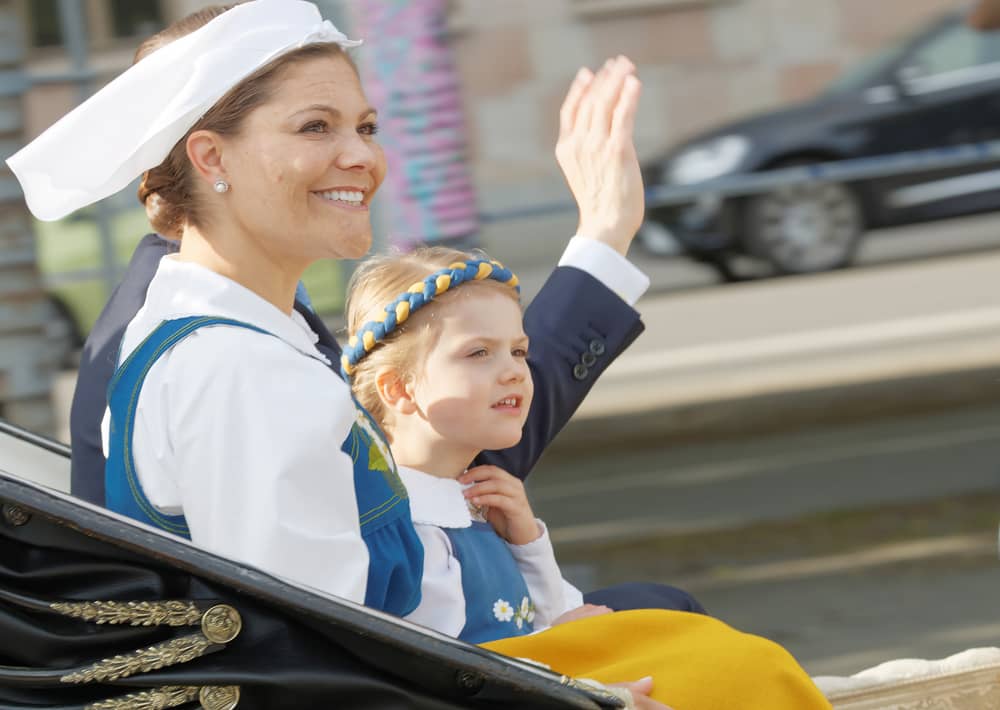
Table of Contents
What is Sweden’s traditional clothing?
Sweden’s traditional clothing typically consists of some sort of long skirt, blouse, apron, socks, and leather shoes. This is the traditional clothing typically worn by women. For men, traditional clothing typically consists of trousers, long socks, and a coat of some kind.
The traditional clothing of Sweden has changed throughout the years. Clothing for women was seen as more cultural due to men’s abandonment of fashion in the name of so-called masculinity.
What even counts as traditional clothing? Traditional clothing is typically a costume or clothing that is worn by a group from a certain area, religion, society, or culture. This type of clothing is used as a form of togetherness, uniformity, and identity. There are many different forms of traditional clothing for many groups of people.
The traditional clothing worn in Sweden takes on different forms based on the class and region of that person. Socialism played a huge role in what people wore traditionally. Over time, traditional wear evolved, changing what is popularly recognized as Swedish traditional clothing today.
Clothing traditionally worn in Sweden has a masculine and feminine version. Like all forms of fashion, the clothing worn by women continued to evolve, while the traditional clothing for men stayed more or less the same.
Swedish traditional clothing for males
Men in Sweden would traditionally wear trousers with long socks. A jacket made out of some sort of handspun material or animal skin would also be worn. The style of the trousers may differ depending on the class or region you were in at the time.
Traditionally, trousers worn by men stopped right below the knee, hence the need for longer socks. The national dress code at the time called for white and blue trim for formal occasions. Embroidery was a common decoration used for men’s trousers.
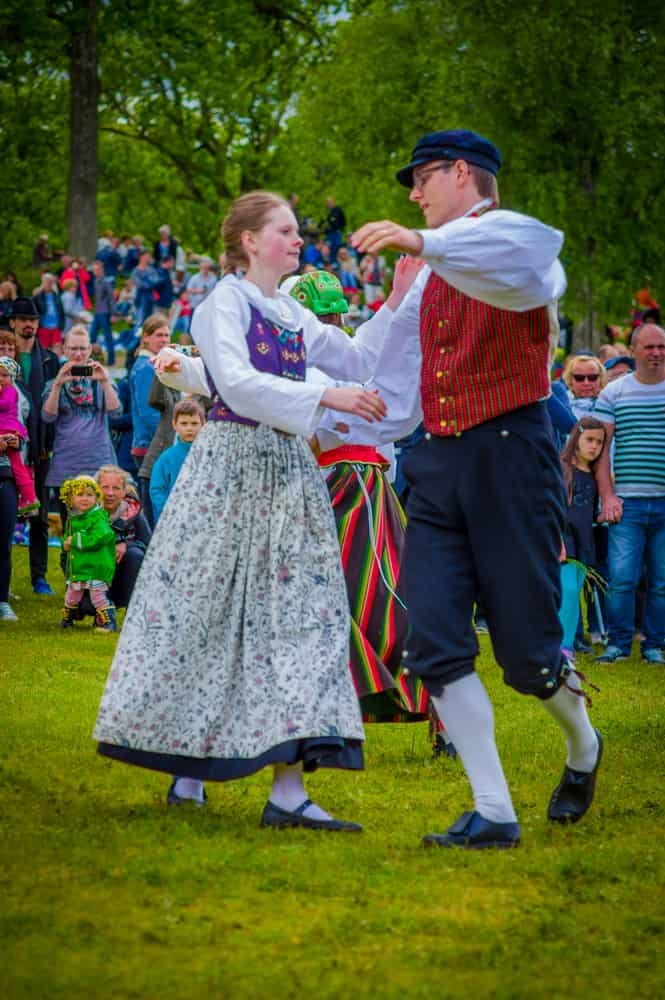
The different types of dress a person wore were heavily recommended and even regulated by one’s region.
In some places, the wrong style of dress or fabric could even result in some sort of punishment or fine at the time. King Gustav III created a dress code in the late 1770s that regulated men’s and women’s clothing. The dress code was more so for the upper and middle class, however.
The dress code was enforced for many reasons, one of them being national economics. The fashion industry at that time was also seen as an urban-livelihood. Buying fashion elsewhere could be considered a crime if the purchaser did not have special permission to buy in those regions.
You may also be interested in: What Language Do Swedish People Speak? (Not Just the Obvious One!)
Swedish traditional clothing for females
The traditional Swedish costume for women typically consists of skirts, aprons, stockings, and a hat. The apron was the staple of women’s costumes, although it changed over time. Linen, wool, and other forms of cotton were their main fabric sources.
Traditional clothing for Swedish women was treated the same as it was for men. It was highly recommended that women of a certain class and region wear clothing that correlates with those characteristics. This was related to the regulations that were put in place by and because of King Gustav III in the late 1770s, as mentioned above.
The clothing was usually made at home or by a local tailor. In addition to the fabric materials used to make these, animal skins used to make leather were also another form of material used to make shoes and coats.
Does Sweden have a national costume?
Yes, Sweden does have a national costume (“Nationella dräkten” in Swedish). The National costume is typically worn by the women of the Swedish Royal Family for National Day. It consists of a light blue dress, a yellow apron, a white blouse, socks, and a scarf worn on the head.
The national costume worn today was first made popular by Marta Palme, a designer, in 1903. Sweden’s National Day became a public holiday only in 2004 and the national costume was made official at that point. The national costume is known as Sverigedräkten.
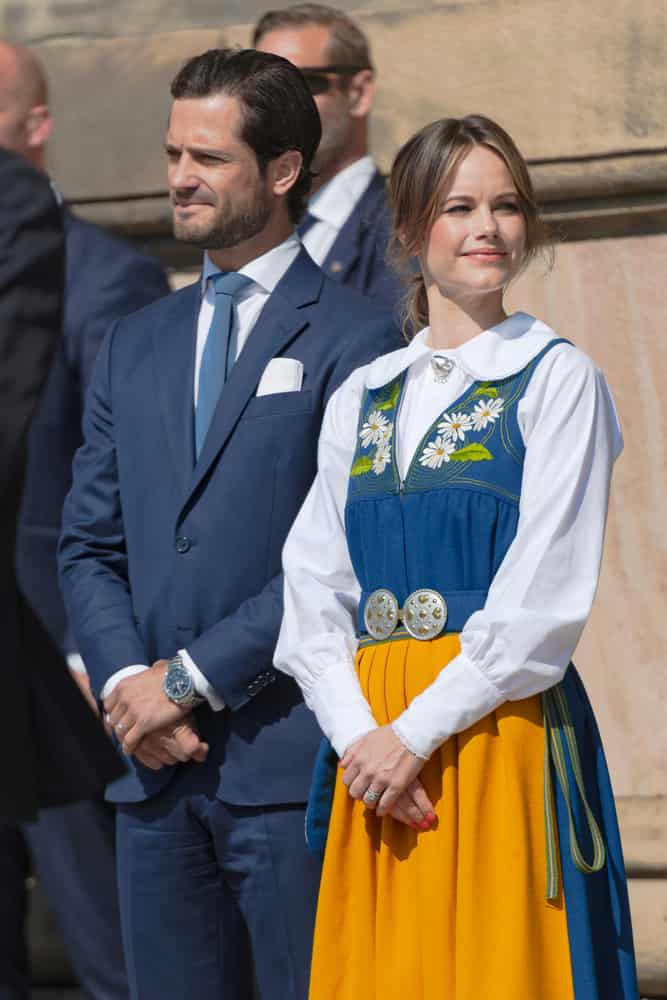
There are plenty of different types of traditional Swedish clothing. However, the dress designed by Marta Palme is widely accepted as the national costume because it seems to embody all of Sweden. Interestingly, men do not wear a version of the traditional costume on National Day.
The color of this dress is mostly yellow and blue, which match the colors of the Swedish flag. This dress is traditionally also worn with long white socks and a white blouse. Like most traditional Swedish costumes, there is an apron worn around the waist.
The national costume was created to instill a sense of pride in Sweden, which is a nice touch given that overt displays of nationalism aren’t really a typical Swedish trait (at least outside of events like the World Cup). This was not the first time a national costume was introduced in order to instill a sense of pride or togetherness in Sweden.
History of the Swedish national costume
The first mention of National Dress in Sweden was in the 1770s. King Gustav III imposed a dress code for the nation’s upper and middle classes. The national costume was established for both men and women.
The national dress code for women and men of the upper or middle class had a masculine and feminine version. There were also uniforms for formal and regular occasions.
King Gustav III wanted to cut down on the country’s spending on foreign and expensive fashion trends. This was also to instill a sense of togetherness in the nation. Many European nations thought the idea to be a silly one, while a few praised him for his decision.
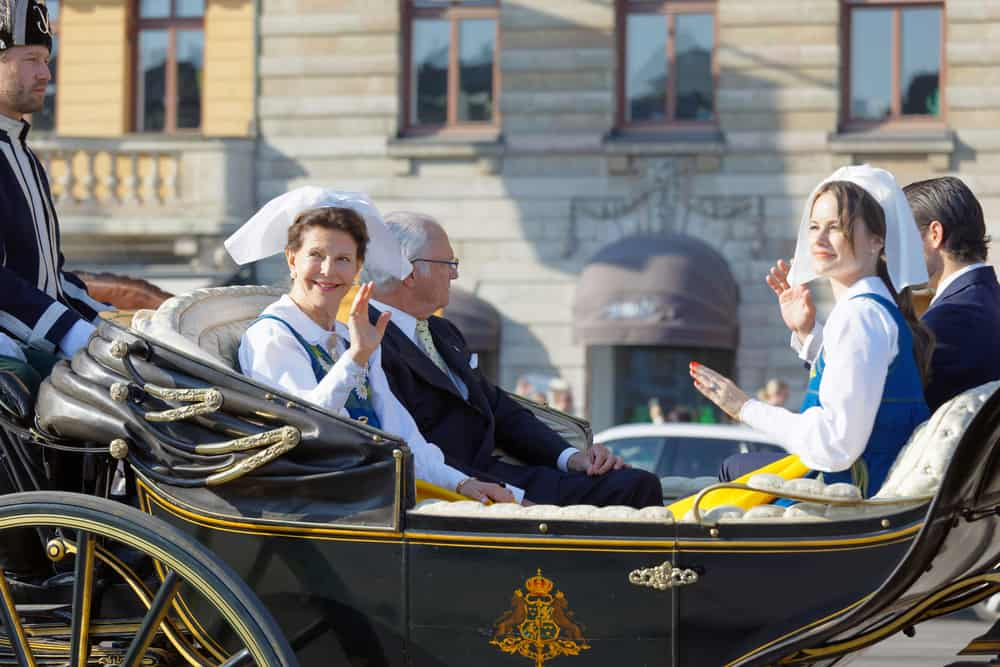
This decision had a profound and lasting effect on Swedish culture and traditional clothing today. The male and female versions of these traditional clothes underwent many changes before eventually evolving into the costume it is today.
The national costume of that time had long been forgotten. During WWII, this way of dressing had gone out of style. However, the current Queen Silvia made it popular once more after wearing it on what is now known as National Day.
How fashion evolved in Sweden
Fashion tells a story about people. Traditional fashion tells a story about a group of people.
A large part of the traditional clothing of Sweden is influenced by their occupations and time and other cultural influences. Sweden is one of the least populated countries in all of Europe. Life in Sweden mainly involved working in the countryside until it became more industrialized.
Swedish traditional clothing origins
Sweden is a part of the European Union and the group of Nordic countries. For thousands of years, Sweden’s population hunted and gathered. A tribe known as Svea began to raid areas along the European coast, which led to some of them settling in those countries.
The word Sweden comes from Svea. The Swea became known as Viking in the old Norse Language, which translates to pirates in English. This connection to Europe is the beginning of European cultural influences from places such as Germany, the Netherlands, and France in Sweden.
Traditional Swedish clothing in the 19th century
In the 19th-century, peasants’ clothing became the style for upper and middle-class people. Women’s peasant clothing was the style of interest due to its similarity and resemblance to folk clothing.
Men’s clothing did not receive the same attention due to its origins. Traditional Swedish male clothing was similar to that of military uniforms. This was quite common for the time when all that was of concern for men was their ability to move. In the 1930s, men in Sweden began to abandon all interest in fashion in order to promote the idea of masculinity within their gender.
Female traditional Swedish peasant clothing was more nostalgic than the clothing worn by upper and middle-class women at the time. This is when the wealthier people started to wear what was considered to be peasant dress at events and festivals.
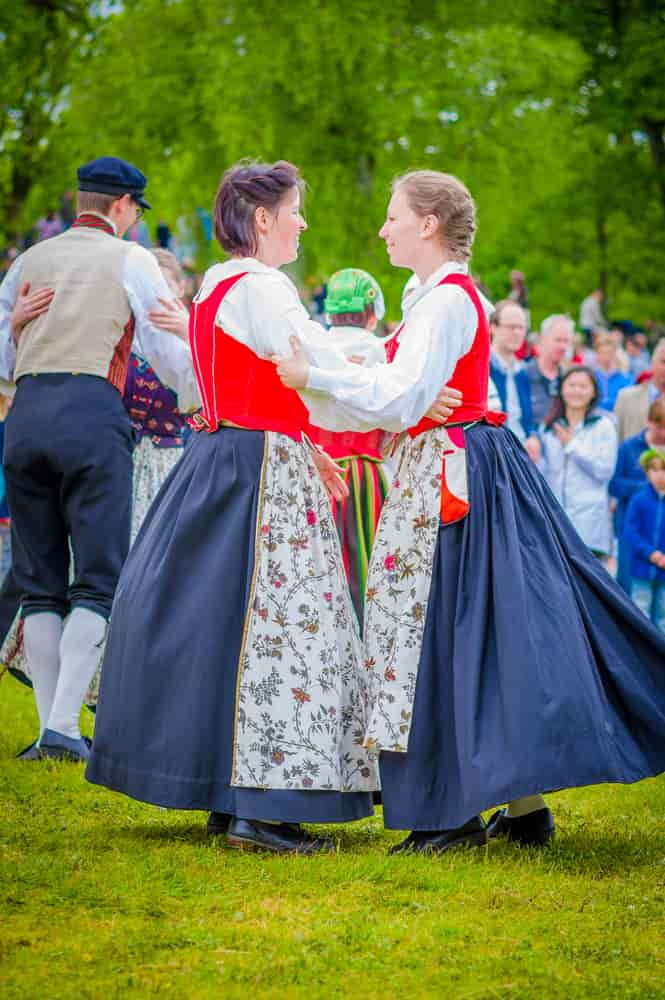
Museums have started collecting different styles of Swedish peasant clothing to commemorate its inspiration for the current national costume design today.
In the 19th century, fashion also began to change. The emancipation movement for women became the main influence on women’s fashion.
Swedish fashion today
Today’s Swedish fashion is very different from the Swedish traditional clothing of the past. What a Swedish resident wears on a daily basis revolves around the weather and outdoor activities, as well as basic fashion concepts.
Sweden is an absolutely beautiful place to explore. However, due to its harsh winters and long summer, it is best to dress practically for a day in this country. When getting dressed for most days in Sweden, it is also important to layer on the clothes, so you are prepared for any weather situation.
Related: Does It Get Dark in Sweden in Summer – or For Months in Winter?
Besides the practical side of things though, the fashion in Sweden can be considered minimalist but very in line with what you would see in other western countries. Don’t forget that this is the country that brought us one of the world’s most famous Swedish clothing brands, H&M, so you’ve probably found yourself wearing Swedish clothing in your day to day life!
Although traditional clothing is no longer worn every day, the national costumes and others like them are worn for special events and festivals still to this day. The Royal Family wears the national costume each year, excluding men.
Different types of traditional Swedish clothing
Wooden clogs
Wooden clogs are an icon of Swedish traditional wear. Even though wooden clogs didn’t originate from Sweden, these unique shoes are a part of its history all the same. The earliest clogs can be dated back to the 1200s, which were found in the Netherlands.
Due to the history of the Netherlands to Germany and its influence on Sweden, clogs became a popular shoe in Sweden. Similar to the Netherlands, wooden clogs were typically shoes worn by peasants.
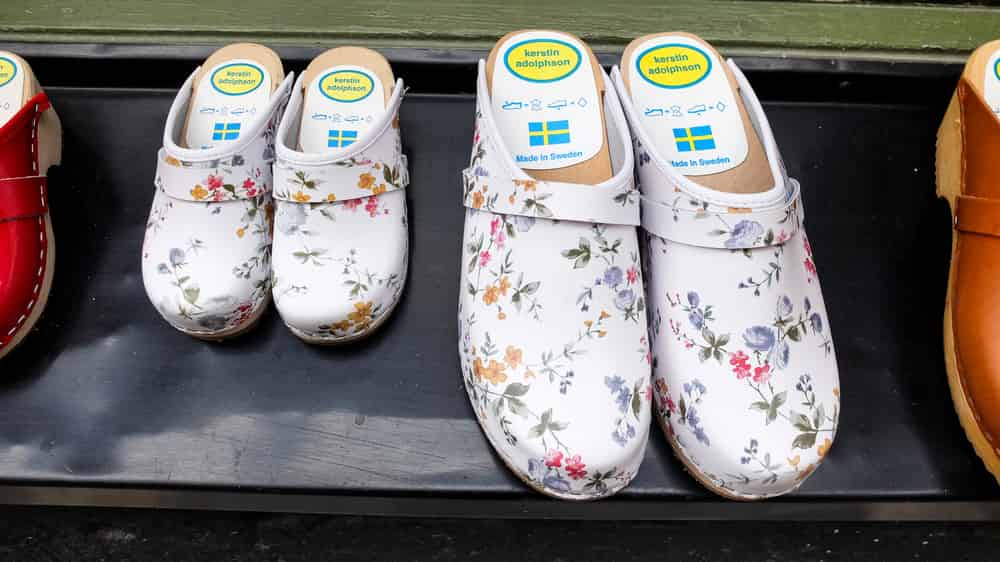
Clogs were usually made with a single block of wood. The traditional Swedish wooden clog was typically made out of willow or poplar wood.
The Swedish wooden clog has since evolved. Its modern design was made popular in the 70s. The shoe is now made out of some sort of leather and wood for a comfortable and more up-to-date style.
The Sverigedräkten
There are many different kinds of Swedish folk dress. The differences are typically based on the region the person resides in.
Sverigedräkten is the dress that represents all of Sweden. The colors represent the Swedish flag. The dress is light blue, while the apron is yellow/gold, like the flag. There are flowers on the costume.
This dress is typically worn with a white blouse, white socks, and bonnet hat. The shoes for this outfit are traditional leather shoes that look similar to what we know as the Mary Jane shoe.
The folkdräkt
The folkdräkt is a type of peasant dress worn daily by commoners. These dresses were worn by people who worked in fields and kitchens. For peasants, the folkdräkt was also worn for festive and fancy occasions, due to this being the only clothing they had at the time.
Folkdräkt was what the sverigedräkten was inspired by. This garment could be nearly any color. Most of the time, these garments would be worn with long warm socks, a blouse, and a hat similar to the national costumes.
According to Swedish museums, Folkdräkt can only be used for costumes with a distinctive and well-documented form of dressing. Men’s traditional Swedish clothing does not have its own, separate term. Instead, male Swedish costumes are usually named after the region.
